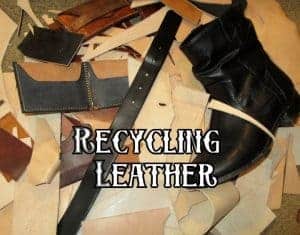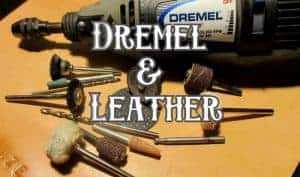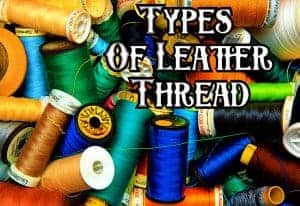
How to Carve Leather
Carving leather can be a fun way to spruce up your leather project. But carving leather is just as much as stamping the leather as it is carving. There are some basic tools you will need to carve and stamp leather. So we will go over how to carve leather in this introduction to carving leather.
Tools used for carving

When carving leather you will not use a razor blade but a swivel knife. This knife has a rotating U-shape holder on top and a barrel used to guide the blade. The blade will be interchangeable if you ever have to replace it due to too much damage. These blades will last a long time if properly sharpened and taken care of.
Aiskaer Sturdy Leather Cutting Tool | Amazon
Buy at Amazon
Features a durable chrome-plated surface with a steel blade. Includes an adjustable rotation bearing that changes the body length of the tool.
We earn a commission if you make a purchase, at no additional cost to you.
Which leads use to talking about stropping the blade. You will want to get a blade sharpener with jewelers rouge to keep the blade in good condition. This will impact your carving as when the blade starts to dull or chip it can tear into the leather. If you have a dull blade you will end up with uneven cuts and tug marks in the leather.
You can make a stropping board out of cardboard or leather and some Tandy Leather jeweler’s rouge. There are many other jewelers rouge chalks you can use but I would recommend Tandy’s. This is a cheap way to keep your blade nice and sharp.
Tandy Leather Jewelers Rouge | Amazon
Buy at Amazon.com
$8.17
Rub on the flesh side of leather for a fine polishing strop.
We earn a commission if you make a purchase, at no additional cost to you.
07/18/2025 09:02 am GMT

Like I said before, stamping is just as important as carving. Stamping tools will provide you to add texture and depth to your carvings. These tools have a wide range of items to choose from. Some may be butterfly stamps and others help create depth to your carvings. I bought a cheap 20 tool stamping set to get started leather crafting.
BigTeddy - 20PCs Leather Different Shape Stamp Punch Set | Amazon
Buy at Amazon
$15.29
This 20pcs leather stamping tool is a great way to get started in leather craft.
We earn a commission if you make a purchase, at no additional cost to you.
07/18/2025 10:02 am GMT
This is a great set to just start out with stamping and carving leather as it is very cheap and comes with great textures and starter stamps.
Lastly, you will need veg-tanned leather as you could guess. This leather is the best for leather crafting items as it can be stamped, molded, carved, and shaped while maintaining the stamped impression.
Any size of leather will work for carving, but if you are just starting you may want to try to use thicker leather. This way you avoid cutting through the leather as you are getting used to the carving knife.
How to carve leather
Before starting to jump into a project, get comfortable with how to carve leather. Use scrap pieces and make a bunch of wavy and sharp cuts to get more familiar with your blade.

Once you get a bit more comfortable with your tools you can start working on a project.
To start your carving you will want to have a design printed/drawn out that you will want to transfer to the leather. For the best results when transferring the design is to wet the leather a bit and tape tracing paper overtop the leather.

Next, you will use an awl or a dull point stylus and trace around the lines. The wet leather will easily set your tracings into the leather. To avoid ripping through the paper, you can also use a stylus tool.
Darice Artist s Tracing Paper 100 Sheets | Amazon
Buy at Amazon
$12.99
Perfect your drawings, sketches, and other creations with this quality artist’s tracing paper. The tablet includes 100 sheets of 9”x12” lightweight, medium surface paper.
We earn a commission if you make a purchase, at no additional cost to you.
07/18/2025 09:02 am GMT
These tools will greatly help during leather carving and we will talk about them a bit more shortly. But they do come with dull point tips to trace your image with.

This will give you a good starting point on where your cuts will be made.
Once the lines have been traced onto the leather you can now take out your carving knife. Feel the leather and wet it a bit more if it feels too dry after you have traced the image onto the leather.
You can use a sponge to wipe the leather or use a spray bottle. You will want to keep these handy while carving since the wet leather will help retain the cuts and stamping of the leather.
Now that the leather is a bit moist you can start carving.
Step 1. Carving the lines
The carving blade is used to create lines on your leather. These lines will provide you with the basic shapes of your design and image.
When using the carving knife you will place your index finger inside the U-shape holder. Next use your thumb and middle finger to hold onto the barrel of the blade.

This will let you rotate the blade while keeping your index finger straight. With your index on top, it will help with applying pressure into the leather and creating smooth lines.
To start you will want to place the blade inside the leather on the beginning of the line at an angle. Allow the point of the blade furthest from you to stab into the leather and pull the blade toward your body.

This is much easier to cut through leather than trying to push the blade away from yourself when making the cuts.
As you follow the line you have marked you will want to keep constant pressure on the blade. This will help keep lines even in width avoid any deep pits in your carving. These pits created from applying too much pressure will stand out in the line after you dye the leather and will become more noticeable.
Attempt to place the blade 1/3 – 1/2 of the way through the leather. Going too deep for your lines will cause the leather to weaken where the carving lines are. This is why starting with heavier weight leathers in the beginning are advised to avoid loosening the leather.
When going around a corner or a circular shape you will want to keep the blade straight up and down when turning the blade. Use your thumb and middle finger to twist the barrel and blade while using your index to keep the blade straight. Turning the blade at an angle while carving will cause the leather to produce a loose flap piece.

This is sometimes desired if you are trying to really make the carving pop out of the piece but should be avoided when learning to carve. If this does happen you can use an edge beveller to cut away the loose piece of leather but it will not be as appealing.
Run your blade through all of the traced lines on the leather to create a groove into your leather. This will provide you with the basis of your image into the leather. Once all the lines have been successfully traced you will move onto smoothing the lines out.

Step 2. Smoothening the lines
This is done many different ways and will depend on the type of tools that are available to use. For smoothing out the lines you will decide which, if not both, side of the lines will need to smoothed out.
Smoothing the lines will cause one side of the line to sink lower than the other side, creating depth to the line. Adding this to the outside of the line will cause the lines to pop out. While smoothing the lines on the inside will cause the image to sink in.
Modeling stylus tools are very smooth and look like something you would see them in a dentist office. But they help smoothen the lines without having to stamp the leather just yet. To use these, you will butt the tool against the carving, press into the leather and follow the carving. Apply pressure to the leather while following the line to sink the leather down.
Asayu Leather Craft Tool Modeling Point Stylus | Amazon
Buy at Amazon
$8.99
Fit for clay sculpture, carved sculpture, fine arts and crafts engraving.
We earn a commission if you make a purchase, at no additional cost to you.
07/18/2025 10:02 am GMT
You may have to go back and do this multiple times to get the accurate look you desire.
These tools will allow for a bit more accuracy than stamping against the lines. But you can still accomplish this smoothing method with only stamps.
Like I said before, a smooth line should not have any fraying leather (unless it is intended for). So use your edge beveller to trim off any unwanted areas of the carved lines.
Now we can move on to the second most important part of carving leather.
Step 3. Stamping
Stamping leather is a whole nother skill in itself. It takes patience and accuracy but can make your carvings come to life.
If you do not have any modeling stylus you will want to start with a smoothening stamp to punch on one side of a line. This tool will press the one side into the leather to create a shadow on your carving.

As I use my mallet to hammer the stamp into the leather I will push on the stamp. This will move the stamp away from the line so I can “feather” the stamping. This will make the line look sunken into the leather while raising it to the surface of the leather.
When you begin stamping you will most likely need to wet the leather again. This will help the leather form and keep the stamped shape in the leather. After wetting the leather, take the smooth stamp and hammer (mallet) the stamp straight down on one side of the line.
Leather Carving Hammer Mallet | Amazon
Buy at Amazon
$9.99
Leather mallet is a leathercraft striking tool to print kinds of figures on the leathercraft. Features a high-quality environmental NYLON head that is perfect for Leathercraft work without harm.
We earn a commission if you make a purchase, at no additional cost to you.
07/18/2025 10:02 am GMT
To get the best results when stamping, treat the stamps as a chisel stitching punch. In order to get the most smooth and accurate results you will want to have the stamp as straight as you can.
Now saying that there is a catch to using stamps on their sides or edges to create a smaller stamped texture. This can be difficult at first but with practice, you will be able to learn the angles to face the stamps.
After you have smoothed down the lines you will want to add some more texture. This texture is all personal preference and can be played around with till you find what textures you personally like.

But we will go over a few common stamps that should be in the kit linked above or purchased when getting into carving leather.
The seashell looking stamps create very good textures for creating natural images into leather. These will help add lines and depth to flowers, plants and other floral type designs.

The same goes with the corner rough stamps. This create almost veins you would see in plants. They both can be used at an angle when creating depth in a very tight area.

One, must have, if you plan on carving flowers is a center flower stamp. These stamps help create the eye of a flower where you will easily build from. They give a very quick bubbled centerpiece for flowers.

Now like I said, it depends on personal preference but also what it is you will be carving. These stamps are very common for natural, floral images, but could be useless if you are creating Celtic designs.
After stamping away at your leather you may want to add a couple extra details
Step 4. Going back with the carver tool
Once you have stamped depth and texture into your image you may want to add some extra details. This will add to your own personal carving style.
If you don’t like heavy stamping, try cross-hatching the leather like a pen and paper image to create a background.

Add extra lines for details around flowers and plants. Add some extra veins in your plants or extra marks in your stamped texture. The options are limitless. But just like a drawing, after adding shadow, you may want to go back to add a couple extra marks to make the piece pop. And this will be the best time for that.

Step 5. Finishing the leather
If you carved into un-dyed natural veg-tanned leather, now will be a good time to add some dye. When you dye a carving, it makes the image stand out much more than it already had. Also get creative with the dye, add darken around the background and lighter dye in the foreground. This will add to the affect of the carved leather.
You can check out our ‘2 Ways to dye leather‘ to help better understand how to dye leather.

If dye is not what you are looking for, try painting the leather. Some leather paint is much more vibrant than any leather dye and go very well with carvings.
Once you have played around with some colors don’t forget to seal your dye/paint and carving. Use whichever type of leather sealant that you work with and let sit.
Once this has dried you will have a completed carved piece of leather ready to be crafted into an item or hung up on a wall.

Adding an antique finish to carvings also creates a very cool look to your work. This will help make the carved leather look more worn and aged. We have 3 ways to age leather that talk a bit about the antique finish and carved leather.
Finished
Hoped this helped introduce the process of how to carve leather and gave some ideas for your next project. Carving leather definitely takes some patience just like any other leather crafting skill. So start off small and test your tools on random scrap pieces of leather before overwhelming yourself on a big piece.









